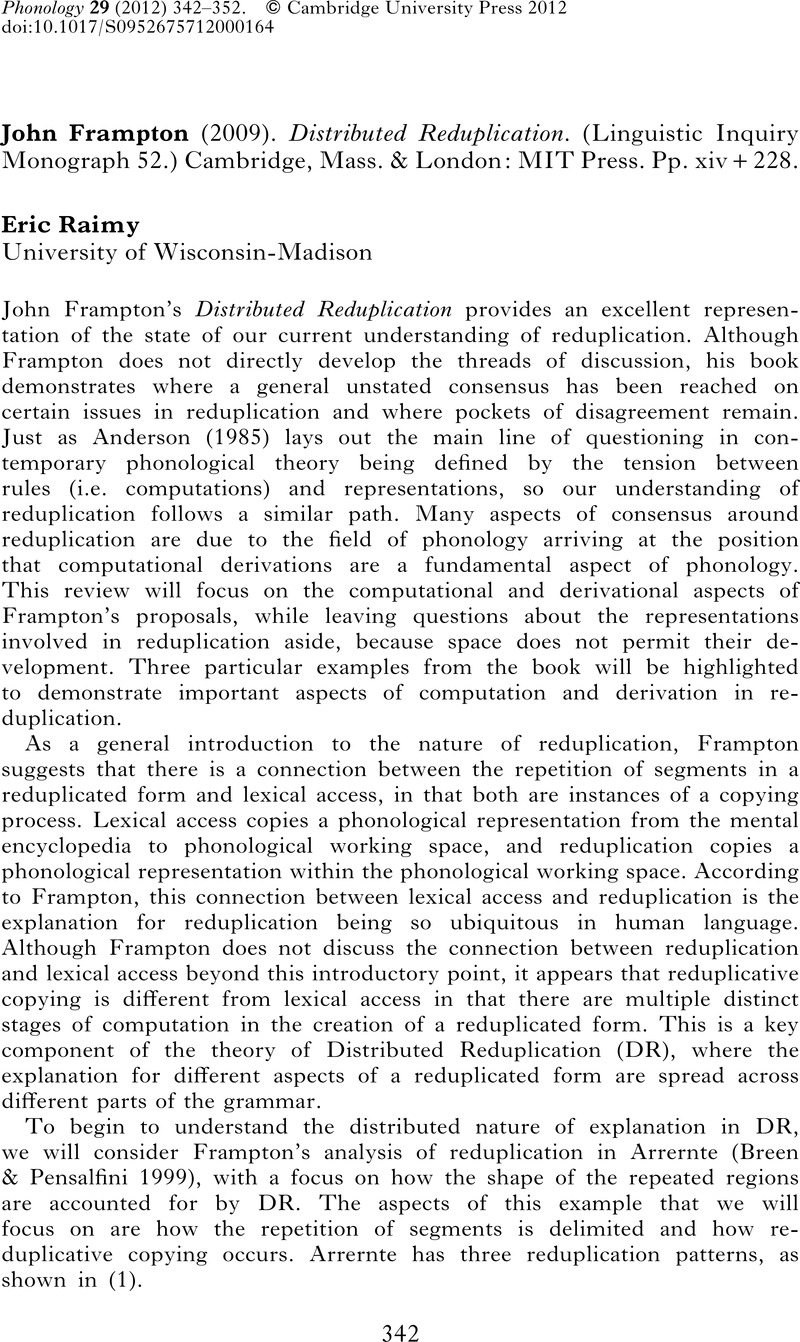No CrossRef data available.
Article contents
John Frampton (2009). Distributed Reduplication. (Linguistic Inquiry Monograph 52.) Cambridge, Mass. & London: MIT Press. Pp. xiv+228.
Published online by Cambridge University Press: 06 September 2012
Abstract
An abstract is not available for this content so a preview has been provided. Please use the Get access link above for information on how to access this content.

- Type
- Book Review
- Information
- Copyright
- Copyright © Cambridge University Press 2012
References
REFERENCES
Anderson, Stephen R. (1985). Phonology in the twentieth century: theories of rules and theories of representations. Chicago: University of Chicago Press.Google Scholar
Breen, Gavan & Pensalfini, Rob (1999). Arrernte: a language with no syllable onsets. LI 30. 1–25.Google Scholar
Chung, Chin Wan (1999). Reduplication in Korean. PhD dissertation, Indiana University.Google Scholar
Embick, David (2010). Localism versus globalism in morphology and phonology. Cambridge, Mass.: MIT Press.Google Scholar
Halle, Morris & Marantz, Alec (1993). Distributed morphology and the pieces of inflection. In Hale, Kenneth & Keyser, Samuel Jay (eds.) The view from building 20: essays in honor of Sylvain Bromberger. Cambridge, Mass.: MIT Press. 111–176.Google Scholar
Harris, James & Halle, Morris (2005). Unexpected plural inflections in Spanish: reduplication and metathesis. LI 36. 195–222.Google Scholar
Hyman, Larry M., Inkelas, Sharon & Sibanda, Galen (2009). Morphosyntactic correspondence in Bantu reduplication. In Hanson, Kristin & Inkelas, Sharon (eds.) The nature of the word: studies in honor of Paul Kiparsky. Cambridge, Mass.: MIT Press. 273–309.Google Scholar
Inkelas, Sharon & Zoll, Cheryl (2005). Reduplication: doubling in morphology. Cambridge: Cambridge University Press.Google Scholar
Kiparsky, Paul (2010). Reduplication in Stratal OT. In Uyechi, Linda & Wee, Lian Hee (eds.) Reality exploration and discovery: pattern interaction in language and life. Stanford: CSLI. 125–142.Google Scholar
Kiparsky, Paul (2011). Compensatory lengthening. In Cairns, Charles E. & Raimy, Eric (eds.) Handbook of the syllable. Leiden & Boston: Brill. 33–69.Google Scholar
McCarthy, John J. (2010). Studying Gen. Journal of the Phonetic Society of Japan 13:2. 3–12.Google Scholar
McCarthy, John J., Kimper, Wendell & Mullin, Kevin (2010). Copying prosodic constituents. Ms, University of Massachusetts Amherst. Available as ROA-1080 from the Rutgers Optimality Archive.Google Scholar
McCarthy, John J. & Prince, Alan (1995). Faithfulness and reduplicative identity. In Beckman, Jill N., Dickey, Laura Walsh & Urbanczyk, Suzanne (eds.) Papers in Optimality Theory. Amherst: GLSA. 249–384.Google Scholar
Nevins, Andrew (2010). Locality in vowel harmony. Cambridge, Mass.: MIT Press.CrossRefGoogle Scholar
Raimy, Eric (2000a). The phonology and morphology of reduplication. Berlin & New York: Mouton de Gruyter.CrossRefGoogle Scholar
Raimy, Eric (2009). Deriving reduplicative templates in a modular fashion. In Raimy, Eric & Cairns, Charles E. (eds.) Contemporary views on architecture and representations in phonology. Cambridge, Mass.: MIT Press. 383–404.CrossRefGoogle Scholar
Raimy, Eric (2011). Reduplication. In van Oostendorp, Marc, Ewen, Colin J., Hume, Elizabeth & Rice, Keren (eds.) The Blackwell companion to phonology. Malden, Mass.: Wiley-Blackwell. 2383–2413.Google Scholar
Yu, Alan C. L. (2007). A natural history of infixation. Oxford: Oxford University Press.Google Scholar


